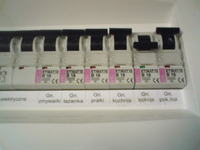I am asking for advice.
In the new apartment I just had kitchen fitters, they turned on some saws, etc. The next day I noticed that there was no electricity in the sockets in the rooms. I looked in the fuse box and of course one of them (the one from the socket) was OFF. Unfortunately, as if I fell down, I lift the lever up to ON, but the lever does not put any resistance (which is noticeable when switching the levers in the other fuses) and does not turn on the fuse - i.e. the color does not change from green to red in the window, and the lever falls loosely to bottom.
Does the described symptom mean that the fuse must be replaced, or the fuse is OK, but there is a short circuit in the electrical system?
I would like to add that there are currently no devices connected to the sockets in the rooms.
Designation of the ETIMAT 10 B16 fuse, details in the attached photo:

In the new apartment I just had kitchen fitters, they turned on some saws, etc. The next day I noticed that there was no electricity in the sockets in the rooms. I looked in the fuse box and of course one of them (the one from the socket) was OFF. Unfortunately, as if I fell down, I lift the lever up to ON, but the lever does not put any resistance (which is noticeable when switching the levers in the other fuses) and does not turn on the fuse - i.e. the color does not change from green to red in the window, and the lever falls loosely to bottom.
Does the described symptom mean that the fuse must be replaced, or the fuse is OK, but there is a short circuit in the electrical system?
I would like to add that there are currently no devices connected to the sockets in the rooms.
Designation of the ETIMAT 10 B16 fuse, details in the attached photo:



